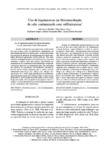Please use this identifier to cite or link to this item:
http://www.alice.cnptia.embrapa.br/alice/handle/doc/940806| Title: | Uso de leguminosas na fitorremediação de solo contaminado com sulfentrazone. |
| Authors: | MADALÃO, J. C.  PIRES, F. R.   CHAGAS, K.   CARGNELUTTI FILHO, A.   PROCOPIO, S. O.   |
| Affiliation: | JOÃO CARLOS MADALÃO, UFV; FÁBIO RIBEIRO PIRES, UFES; KRISTHIANO CHAGAS, UFES; ALBERTO CARGNELUTTI FILHO, UFSM; SERGIO DE OLIVEIRA PROCOPIO, CNPSO. |
| Date Issued: | 2012 |
| Citation: | Pesquisa Agropecuária Tropical, Goiânia, v. 42, n, 4, p. 390-396, out./dez. 2012. |
| Description: | RESUMO: Resíduos de sulfentrazone podem permanecer no solo por cerca de dois anos, oferecendo risco de contaminação a lençóis freáticos e possibilitando o cultivo de espécies susceptíveis. Diante disto, a fitorremediação pode representar uma opção para a descontaminação de áreas que sofreram com intensas aplicações deste herbicida. O presente trabalho avaliou o potencial remediador das espécies Crotalaria juncea, Canavalia ensiformis, Cajanus cajan e Cajanus cajan (anão), com relação ao herbicida sulfentrazone, utilizando-se o milheto (Pennisetum glaucum) como planta bioindicadora. O experimento foi instalado em casa-de-vegetação e os tratamentos compostos pela combinação entre as quatro espécies citadas, além da testemunha, e quatro doses de sulfentrazone (0 g i.a. ha-1, 200 g i.a. ha-1, 400 g i.a. ha-1 e 800 g i.a. ha-1). Foram avaliadas a altura de plantas, fitotoxicidade ao sulfentrazone e biomassa fresca e seca da parte aérea. Quando P. glaucum foi cultivado após C. juncea, apresentou maior ganho em biomassa e maior altura, e os sintomas de fitotoxicidade foram menos acentuados. C. juncea apresentou a maior capacidade de fitorremediar solos contaminados com sulfentrazone.ABSTRACT: Use of leguminous plants for phytoremediation of soil contaminated with sulfentrazone. Residual sulfentrazone may remain in the soil for around two years, being a source of groundwater contamination and preventing the growth of usceptible plants. So, phytoremediation may represent an option for decontaminating areas which were highly affected by applications of this herbicide. This study aimed at evaluating the potential of Crotalaria juncea, Canavalia ensiformis, Cajanus cajan and Cajanus cajan (dwarf) for remediation of soil contaminated with sulfentrazone, using millet (Pennisetum glaucum) as a bioindicator plant. The experiment was installed in a greenhouse and treatments consisted of the four species already mentioned, plus a control, and four sulfentrazone doses (0 g a.i. ha-1, 200 g a.i. ha-1, 400 g a.i. ha-1 and 800 g a.i. ha-1). Plants height, phytotoxicity to sulfentrazone and fresh and dry matter were evaluated. When P. glaucum was grown after C. juncea, the fresh and dry matter, as well as plant height, were higher, while the phytotoxicity symptoms were less evident. C. juncea showed the best results for phytoremediation of soils contaminated with sulfentrazone. |
| Thesagro: | Herbicida residual Solo |
| NAL Thesaurus: | Herbicide residues Soil |
| Type of Material: | Artigo de periódico |
| Access: | openAccess |
| Appears in Collections: | Artigo em periódico indexado (CNPSO)  |
Files in This Item:
| File | Description | Size | Format | |
|---|---|---|---|---|
| uso.pesq.agrop.trop.procopio.pdf | 282,51 kB | Adobe PDF |  View/Open |









